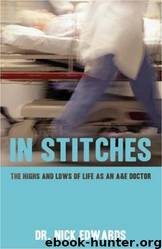In Stitches: The Highs and Lows of Life as an a & E Doctor by Nick Edwards

Author:Nick Edwards
Language: eng
Format: mobi
Tags: Physicians, Allied Health Services, Medical, Health Policy, Emergency physicians, Emergency Medical Services, Public Health
ISBN: 9781905548705
Publisher: Friday
Published: 2007-11-30T01:55:55+00:00
People who work in the A&E department
There are lots of people who work in A&E–not just doctors and nurses. Here is a quick review of the people I spend my days with.
Emergency nurse practitioners (ENPs)–specially trained nurses who can treat minor injuries independently. They have taken a lot of the pressure off A&E doctors and done more for reducing waits in A&E than any other development. They write a lot of notes for each patient and can see fractures on X-rays (which I need a magnifying glass for) from 10 metres.
Pharmacists–go round improving doctors’ spelling with green pens. Often save the arses of junior (and senior) doctors.
Receptionists–run the whole show. Know how to do everything. Massive amounts of common sense. I often think that if we sacked all the doctors and gave the receptionists a stethoscope, the NHS would be a better place. They keep the waiting masses in order with flair and frequently an iron rod.
Consultants–the senior doctors. Have years of experience and when they are on the shop floor, they make the place so much more efficient and patients get excellent treatment. Unfortunately, they are often in their offices answering complaints, or at meetings explaining why patients have ‘breached’ their 4-hour rule (probably because the consultants were in a meeting explaining why other patients ‘breached’ as opposed to seeing patients)
Registrars/staff grade doctors/SpR doctors–below the consultants, more experienced than the SHOs. We are the ones who, when asked a question, will take off our glasses and put them in our mouths to look as if we have some intelligence and knowledge when really we are just playing for time.
SHOs/F2–the junior rank of doctors working in A&E. Some are excellent. All are hard working–or forced to work hard by their appalling rotas which often mean that they work mostly unsocial shifts so that the more senior doctors can have a life. However, they only work for 4–6 months in the A&E department, so medical staffing planners can get away with it without too many complaints.
A&E secretary–she knows everything and everybody, does everything, finds everything and without her the place would fall apart. The most amazing organisational skills I have seen. This is not being sexist, but I don’t think a man could ever replace our secretary –we can’t multitask and she can.
Sisters–the lynchpins of A&E. They make sure that a ‘shift’ is run properly, coordinate the department along with the senior doctors, run the show, get paid bugger all and if they want promotion get pushed into management.
Charge nurses–male sisters. I call them brothers. They don’t find it amusing except the vegetarian communist one, who keeps on trying to get me to join his commune.
Staff nurses–the work horses of the A&E. Usually excellent, but there are a few disgruntled and eccentric ones, especially the breed known as ‘agency staff nurses’.
Health-care assistants–do the jobs nurses used to do, except give out drugs. Get paid a criminally small amount for such a vital job. It’s a disgrace.
Physiotherapists–specialists in musculoskeletal problems. Female ones are usually very fit and male ones good at sport.
Download
This site does not store any files on its server. We only index and link to content provided by other sites. Please contact the content providers to delete copyright contents if any and email us, we'll remove relevant links or contents immediately.
The Art of Coaching by Elena Aguilar(52965)
Thinking, Fast and Slow by Kahneman Daniel(12082)
The Art of Thinking Clearly by Rolf Dobelli(10232)
The 5 Love Languages: The Secret to Love That Lasts by Gary Chapman(9605)
Mindhunter: Inside the FBI's Elite Serial Crime Unit by John E. Douglas & Mark Olshaker(9209)
When Breath Becomes Air by Paul Kalanithi(8336)
Periodization Training for Sports by Tudor Bompa(8173)
Becoming Supernatural by Dr. Joe Dispenza(8127)
Turbulence by E. J. Noyes(7942)
Bodyweight Strength Training by Jay Cardiello(7844)
Therapeutic Modalities for Musculoskeletal Injuries, 4E by Craig R. Denegar & Ethan Saliba & Susan Saliba(7689)
Nudge - Improving Decisions about Health, Wealth, and Happiness by Thaler Sunstein(7622)
The Road Less Traveled by M. Scott Peck(7524)
Enlightenment Now: The Case for Reason, Science, Humanism, and Progress by Steven Pinker(7242)
Mastermind: How to Think Like Sherlock Holmes by Maria Konnikova(7233)
Win Bigly by Scott Adams(7097)
Kaplan MCAT General Chemistry Review by Kaplan(6868)
Why We Sleep: Unlocking the Power of Sleep and Dreams by Matthew Walker(6620)
The Way of Zen by Alan W. Watts(6512)
